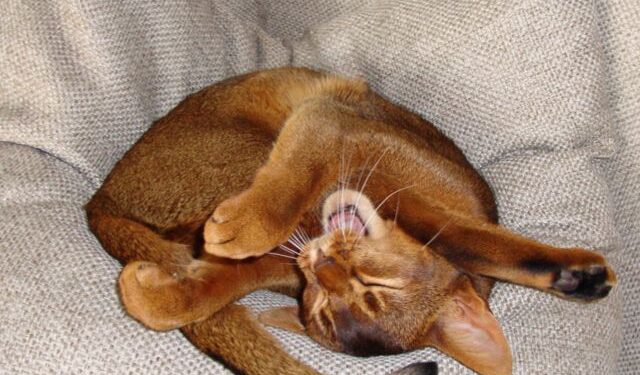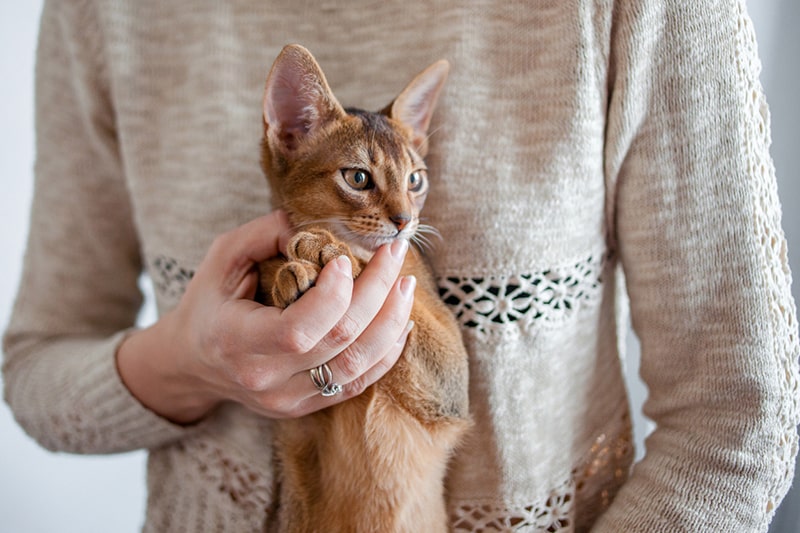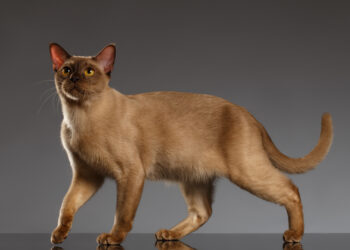Unveiling the Active Abyssinian Cat: Your Guide to a Playful Feline Companion
The Abyssinian cat, affectionately nicknamed “Aby,” stands out as a medium-sized feline boasting a lean, muscular physique and a sleek short coat. In contrast to many other domestic cat breeds, the Abyssinian is exceptionally lively and spirited, displaying a penchant for scaling tall furniture, engaging with toys, and indulging in interactive play with its human companions. This breed’s amiability extends to children and other pets, making it an excellent addition to any energetic household. However, it’s advised to consider providing your Aby with a feline companion, as they are highly sociable and may grow restless if left alone for extended periods.

Breed Spotlight: Unveiling the Abyssinian Cat
Alternate Name: Aby
Personality Traits: Friendly, interactive, animated, active, and playful
Weight Range: Up to 12 pounds
Length: Reaching up to 28 inches
Coat Type: Short Hair
Variety of Coat Colors: Ruddy, red, blue, cinnamon, or fawn
Distinct Coat Patterns: Solid and ticked
Eye Shades: Encompassing green or gold hues
Lifespan: Up to 15 years
Hypoallergenic: Moderately
Origin: Emerged in Indian Ocean coastal regions and parts of southeast Asia
Unmasking the Abyssinian’s Characteristics
The Abyssinian cat exudes a friendly and outgoing disposition, relishing in playful activities and seeking to avoid solitude. Despite its medium size, this social feline adapts seamlessly to diverse environments, finding joy in independent pursuits such as playing with toys or sprinting up and down stairs (or scratching posts). However, its sociable nature inevitably draws it towards seeking attention from its fellow housemates, regardless of their species. Remarkably, even upon reaching maturity around one year of age, the Abyssinian retains its youthful vigor, coexisting harmoniously with its elegant and refined appearance.
- Affection Level: Medium to High
- Friendliness: Medium to High
- Child Compatibility: Medium to High
- Pet Friendliness: Medium to High
- Exercise Requirements: Moderate
- Playfulness: High
- Energy Levels: High
- Intelligence: High
- Vocalization Tendency: Low
- Shedding Amount: Low
A Glimpse into the Abyssinian’s Historical Roots
Legend traces the Abyssinian cat back to the days of Egyptian pharaohs, yet some enthusiasts contend that selective breeding of silver and brown tabby cats led to their development in Britain.
Genetic analysis suggests that Abyssinians likely originated along the coastal regions of the Indian Ocean and parts of southeast Asia. A ruddy-colored, ticked-markings cat preserved in taxidermy at the Leiden Zoological Museum in the Netherlands lends credence to this notion, with speculation that the cat hailed from India.
The moniker “Abyssinian” is thought to stem from Zula, the feline featured at the 1871 Crystal Palace Cat Show, allegedly imported from Abyssinia (present-day Ethiopia). The variation in coat colors and patterns likely results from interbreeding between Abyssinians and other domesticated cats.
American cat enthusiasts initiated the import of Abyssinians in 1900, later establishing breeding programs in the 1930s. This import was crucial as the breed faced near-extinction in Europe during World War II. Subsequently, Abyssinian populations flourished, cementing their status as one of the globe’s most beloved cat breeds.
Nurturing Your Abyssinian Companion
Despite their penchant for exercise and heightened energy levels, Abyssinians can be relatively low-maintenance companions. Their short coats and minimal shedding mitigate grooming demands. Regular combing and sporadic baths effectively eliminate dander, debris, and loose fur.
Prioritizing oral hygiene remains paramount, with daily brushing offering optimal benefits in combating periodontal disease. Even weekly brushing helps safeguard your cat’s dental health.
Inspect your Aby’s ears weekly, clearing away dirt, debris, or potential signs of infection. Utilize a soft cotton cloth for cleaning, avoiding cotton swabs that may harm delicate inner-ear structures.
Abyssinians thrive on interactive play and cat toys. Installing a cat tree or wall-mounted shelves enhances their environment, granting opportunities for climbing and perching.
Confronting Common Health Concerns
Although generally robust, Abyssinians are prone to certain conditions. Vigilance is key for detecting:
- Periodontal Disease: Infection affecting teeth-supporting tissues
- Patellar Luxation: Hereditary susceptibility to kneecap dislocation
- Progressive Retinal Atrophy: Degenerative eye ailment potentially leading to blindness
Consult your veterinarian for strategies to ensure your cat’s wellbeing and longevity.

Unveiling the Abyssinian’s Visage
The Abyssinian boasts a medium-sized, well-developed physique by one year of age. Distinctive large ears contribute to its wild, savannah-like appearance. The short, dense coat spans shades of ruddy, red, cinnamon, blue, or fawn (with fawn-hued females being rare and valued). Almond-shaped eyes, captivating in green or gold, complete the mesmerizing visage.
Nourishment and Dietary Regimen
Cater to your cat’s specific dietary requirements, accounting for age, gender, and activity levels. Leverage feeding guidelines from reputable cat food brands or engage your veterinarian for personalized insights. Remember that overfeeding can trigger health issues associated with obesity.
The Abyssinian at a Glance
Abyssinian cats thrive indoors, particularly in spacious abodes, given they have companionship and playthings. Their affinity for climbing renders cat trees, stairs, and elevated surfaces a source of endless amusement. Characterized by robust health and low maintenance, the Abyssinian proves an easily manageable companion across its 15-year lifespan.
Central to this breed’s contentment is attention and interaction, whether with humans or fellow furry residents. If your schedule is demanding, consider introducing an equally playful companion cat to satisfy your Aby’s social needs.
Pros:
- Amiable with children and other pets
- Playful nature with heightened energy
- Minimal grooming requirements
Cons:
- Demand for exercise and playtime, potentially challenging for busy households
- Preference for a companion cat
- Seasonal shedding tendencies
Decoding Feline Antics: Unraveling the Whys and Hows
Wondering about your cat’s quirky behavior? Explore the reasons behind their antics and strategies to manage them.
Embracing the Abyssinian: Adoption Possibilities
Locating a purebred Abyssinian at a local shelter might prove challenging, so consider rescue groups in your vicinity. Petfinder.com simplifies the search for pets, allowing you to filter by breed and location.
In the case of breeder acquisition, prioritize ethical and responsible practices. A reputable breeder adheres to breed standards, producing healthy cats. Beware of signs like multiple cats on-site or unhealthy conditions. Avoid breeders shipping cats or demanding





















